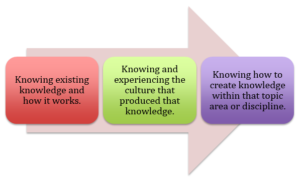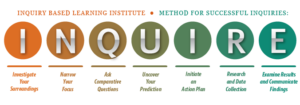1. Overview
After exploring the topic of Chinese cultures about Hot Pot with relevant mandarin, I have decided my project is a structured inquiry-based learning, which I give students the open questions and they could use the methods that I gave them or create their own methods to figure out the answers about the culture differences through learning Mandarin. My approach will be the combination between routines for visiting the Hot Pot and classroom in BC high school of Grade 12 teaching for summary and conclusion. From the my view, I would focus on moving students beyond general curiosity of language learning into the realms of critical thinking and understanding for cultures differences and this could be an interesting and unique learning experiences for students.
2. Topic Highlights, Research, Resources:
(1) Teacher must encourage students to ask questions and support them through the investigation process, understanding when to begin and how to structure an inquiry activity (McKinney, 2018). Thus, I suppose that this inquiry project is living and lifelong learning for its diversity in cultures, which is also the aim for the big idea of BC curriculum that language learning is a lifelong process.
(2) In an inquiry, the questions asked and the work accomplished are seen as openings and enrichments towards understanding more about the topic itself. And it’s understanding that is relevant in the real world (Coffman, 2017). Therefore, I think this inquiry project could use various strategies to increase understanding and produce oral language by practicing Mandarin in the Chineses restaurant, which could be closely incorporated with the thinking and communication’s regulations of BC Curriculum.
(3) While some may argue inquiry learning takes too much time and it is more efficient to simply give students the information they need to know, this does not lead to true understanding. Students need to engage in real work that reflects the work someone in the field might tackle (Pedaste & Mitt, 2020). So I believe that Recognizing the regional and ethnic diversity of language and culture in China and in Chinese communities throughout the world and engaging in experiences with Mandarin-speaking people and Chinese communities such as Hot Pot restaurant, where is full with Chinese culture’s atmosphere and Mandarin speakers. It is also the personal and social awareness disciplined in BC curriculum.
3. Design Thinking and Student Refection:
A large part of this project will be exploration and students and students will be encouraged to reflect on the experiences about their journey in Hot Pot restaurant. Due to the curiosity in students brain, they would be interested in having the necessary conversations with the service in restaurant and it could be a chance for them to practice Mandarin. Every introductions of ingredients and greetings for “Hello” from Mandarin speakers might promote their experiential learning for language tone and pronunciation.
4. Project Framework

(Retrieved from: https://inquiry.galileo.org/)
(1) Guide Questions for teachers:
- What kind of introduction can I make for starting this interesting language learning journey to appeal students’ curiosity ?
- What changes and additions to my routine can I incorporate into my teachings for guiding the students’ exploration of culture and language secrets?
- How can I involve the Mandarin knowledges and be sensitive to the cultures background and educational circumstance?
(2) For students:
Student could share the diverse experiences from eating in different not-local restaurant to compare with each other. Before the learning journey, they could prepare the relevant oral Mandarin knowledges and do a little research about the Hot Pot through internet. In the process of experiential learning, they could feel from bottom to the top about the customs for Chinese table. After this, students would answer the relevant questions to have a reflection foe learning.
Phase 1 (in the first week):
Guiding Questions:
- What is Hot Pot?
- What is the impression of Hot Pot in Chinese History?
- How to say Hot Pot and relevant ingredients in Mandarin?
Students will explore the topic by the guiding of teachers and teaches will have a brief introduction for Hot Pot. Then students will get a general concept about the Hot Pot, which might help them to understand the activities and aims of this project.
Phase 2 (in the second week):
Guiding Questions:
- What are the table manners when we are eating Hot Pot? Is there anything we need to notice?
- How to use Mandarin to communicate with the restaurant service?
- What do we have to use chopsticks when we are eat Hot Pot?
Students will be brought to the Hot Pot restaurant to taste Hot Pot by themselves so they can figure out the relevant questions through eating and doing the table manners. They could also be allowed to answer the questions out their curiosity and share with each others.
Phase 3 (in the third week):
Guiding Questions:
- Why Hot Pot is the most representative food in China?
- What is the differences between Chinese pepper and other pepper such as Indian pepper/ Mexican pepper through students’ own experiences?
- How does the landscape we live in influence the types of foods we can grow and use in our cookings?
- How do certain food become traditional for a specific country / region?
Students will come back to the classroom again to summary their experiences in Hot Pot restaurant and express it in oral speaking Mandarin. They will be separated into groups to talk individually about their thoughts and ideas to come up with the answers.
5. Inquiry-Based Learning Pedagogy:

(Retrieved from: https://www.google.com/search)
(1) Systematic Investigation into a Problem
The cultural field investigation has been illustrated in this project. The very original speaking Mandarin could be founded by communicating with native speakers instant of only sitting in the classroom to follow the radio or watch Chinese channels for practicing. Food is one of the most typical cultures for leaners to have access to.
(2) Student-Centred Experiential Learning
Teachers in this project are activators of learning and ask probing questions meant to clarify the basic assumptions underpinning a truth claim and students would experience the language environment by themselves through eating Hot Pot.
(3) Promoting Deeper Understand of the Learning Contents
This project is not just superficial learning about the language speaking. It is the combination learning of diversity for cultures and customs. Students could get deeper knowledge about Chinese traditions and the conspicuous differences with other cultures.
6. Further Questions:
- Is the scope of the project too ideal to be considered inquiry-based learning?
- How can I apply the specific inquiry-based learning disciplines into this framework?
- How can I clearly guide students in a minimally interferential way?